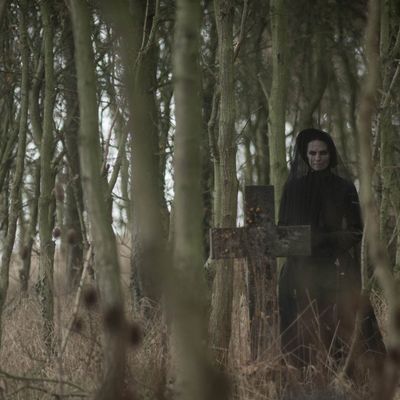
I dont know how you do it, night after night of this  still smiling, a woman in an underground bomb shelter says to schoolteacher Jean Hogg (Helen McCrory) in the opening scene of The Woman in Black 2, as German bombs fall all around them in 1941. Its an odd comment, because nobody actually does much smiling in this film  not even Ms. Hogg. A sequel to 2012s atmospheric Daniel Radcliffestarring horror hit, this new film conjures up a singularly gloomy mood: Its a dour, drab, dark movie, enlivened by some moderately effective chills in the first half but ultimately undone by its downbeat aimlessness.
The earlier film was a Victorian eraÔÇôset chiller that at the very least used its milieu well: The titular ghost haunted a beautifully rambling mansion situated on a stretch of marshland that became an island when the tide rolled in. Now, decades later, Ms. Hogg arrives with a group of children who have been evacuated from London because of the Blitz. They settle into the same mansion, called Eel Marsh House, and soon come the stirrings in the night, the spectral visions, and an epidemic of self-closing doors. Much of the activity revolves around a young orphan (Oaklee Pendergast) rendered mute by the recent loss of his family, who seems to be communing with the ghostly figure of a woman in black. Meanwhile, Ms. Hogg gets welcome help from a dashing pilot she met on the train, played by Jeremy Irvine, the kid from SpielbergÔÇÖs War Horse.
For its first hour or so, The Woman in Black 2 is a reasonably evocative mood piece, effectively utilizing this forsaken house, and those desolate moors, with their craggy, lone trees and ominous mists. Director Tom Harper also composes his shots in such a way that weÔÇÖre always guessing at what might be looming in the dark corners of the frame; his deliberate style rewards our patience. And the film wisely avoids giving us too much explanation as to what, exactly, is going on; it lets us groove on the tension for a while.
That doesnÔÇÖt really last, however. Pretty soon, weÔÇÖre in Jump Scare City, inundated with random blasts of noise and sudden flashes of horrific ghosts and whatnot designed to yank easy jolts out of us. A little bit of this can go a long way to wind us up, but The Woman in Black 2 eventually starts using its jump scares as a crutch, piling them on in the absence of little else to show us; gradually, we become numb to them. And the filmÔÇÖs initially admirable refusal to burden us with too much plot becomes more troublesome as it proceeds ÔÇö we begin to fear that it doesnÔÇÖt actually have anything to say. Even for those of us who remember the plot of the first Woman in Black, this new one has a curious vagueness to it, as if the filmmakers couldnÔÇÖt really be bothered to tell us much about why anything is happening. ThatÔÇÖs not always a bad thing ÔÇö there are few things more annoying than a horror movie that feels it has to keep explaining itself ÔÇö but here, it manifests itself as inertness and uncertainty. And if the filmmakers donÔÇÖt care, why should we? The Woman in Black 2 starts off very well, but it soon loses the thread.


